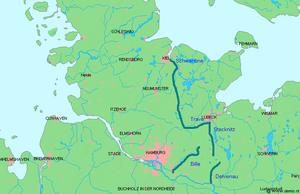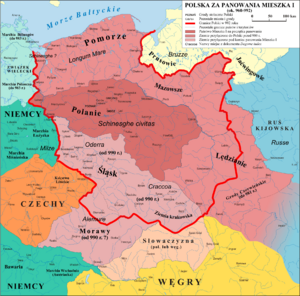Lechites facts for kids
The Lechites (Polish: Lechici, German: Lechiten) were a group of West Slavic tribes. They lived in what is now Poland and eastern Germany. These tribes spoke languages known as Lechitic languages. They are the main ancestors of today's Poles and the Pomeranians. They are also related to the Lusatians and Polabians.
Contents
Early History of the Lechites

The history of the Lechites is deeply connected to the start of the Polish state. According to old Polish stories, Mieszko I became a leader around 960 AD. He likely ruled over many eastern Lechite tribes. Mieszko I brought together several Lechite tribes living east of the Oder. These included the Polans, Masovians, Pomeranians, Vistulans, and Silesians. He united them into one country, which became Poland.
His son, Bolesław I the Brave, continued his father's work. Bolesław set up important church centers in cities like Wrocław, Kołobrzeg, and Kraków. He also created an archbishopric in Gniezno. Bolesław was a strong leader and fought successful wars. He expanded Poland's influence over areas like Bohemia, Moravia, Kievan Rus', and Lusatia. He also made the western Pomeranians pay tribute to Poland. Just before he died in 1025, Bolesław became the first King of Poland.
Main Lechitic Tribes
The Lechites were made up of many different tribes. Some of the most well-known groups were:
- Poles (including the Polans)
- Masovians
- Vistulans
- Silesian tribes (a group of tribes in the Silesia region)
- Pomeranians (including the Kashubians)
- Polabians (who are no longer a distinct group today)
- Obodrites (another large group of western Lechites)
- Sorbs (who still live in parts of Germany today)
Many of these tribes eventually became part of the Polish nation. Others, like the Polabians, slowly disappeared as separate groups.
Lechitic Languages Explained
The West Slavs were the ancestors of several modern peoples. These include the Poles, Pomeranians, Czechs, Slovaks, Sorbs, and Polabians. The northern group of these languages is called the Lechitic group. This group includes the Polish language. It also includes the Pomeranian language, which is now endangered. The Polabian language is no longer spoken.
Silesian is also part of this group. Some people think it's a dialect of Polish, while others see it as its own language. The Sorbian languages are spoken in parts of Germany today. They are somewhere between the Lechitic and Czech-Slovak language groups.
The Name 'Lech' and Its Meaning
The name Lech (or Leszek, Lestko) is very popular in Poland. Many early Polish rulers from the Piast dynasty had this name. Examples include Lestko, Leszek I the White, and Leszek II the Black. The oldest part of Gniezno, a very old Polish city, is called Wzgórze Lecha ("Lech's Hill"). It is also known as Góra Królewska ("Royal Hill").
Lestko was a legendary duke of Poland. He was mentioned in an old book called Gesta principum Polonorum, written between 1112 and 1118. Another old German book from the 10th century mentioned Mieszko I. It said he ruled a tribe called the Licicaviki, who were known as "Lestkowici" (people of Lestek). Historians believe these were the Lendians.
Later, a writer named Wincenty Kadłubek used the names Lechitae (Lechites) and Lechia many times. He used them to describe all of medieval Poland in his book written between 1190 and 1208. An old book from 1273 called Chronicle of Greater Poland also used both "Poles" and "Lechites" to mean the same thing. The name Lechia is still used for Poland in some languages today. For example, it's "Lehia" in Romanian and "Lehistan" in Ottoman Turkish.
Legends of the Lechites
In Polish stories, Lech is a legendary founder of Poland. A famous legend tells of three brothers: Lech, Čech, and Rus. They are said to have founded three Slavic nations: Poland (also called Lechia), Bohemia (now the Czech Republic), and Rus' (Ruthenia). In this legend, Lech founded the city of Gniezno.
The legend goes like this:
Three brothers, Lech, Czech, and Rus, were exploring the wild lands to find a place to settle. Suddenly, they saw a hill with an old oak tree and an eagle's nest on top. Lech said: "I will make this white eagle the symbol of my people. Around this oak, I will build my stronghold. Because of the eagle's nest (Polish: gniazdo), I will call it Gniezdno (modern: Gniezno)." The other brothers went on to find places for their own people. Czech went south to found the Czech Lands, and Rus went east to create Rus'.
A simpler version of this legend, with only Lech and Čech, was first written down in Bohemia. The full story with all three brothers was described in the Kronika wielkopolska ("Greater Poland Chronicle"). This book was written in Latin in 1273.
See also
 In Spanish: Lechitas para niños
In Spanish: Lechitas para niños



